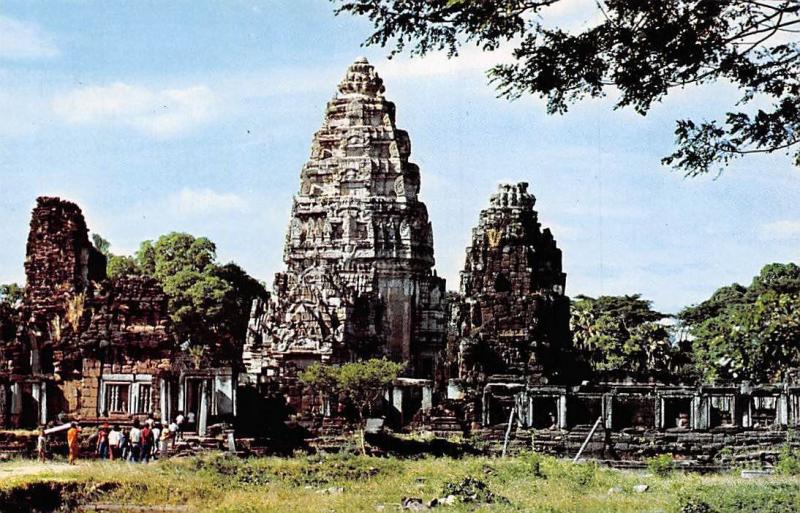University research group sets out to show off the oft-forgotten charms and culture of Phimai
Once the crepe-like rice cake sitting on the filter cloth over the steaming pot is cooked, Saithong Jaidee quickly removes the sheet and dries it on one of the hangers behind her working station – a huge charcoal stove.
The process is repeated until the flour mix has all gone and the hangers are filled with dozens of thin rice sheets, waiting to be air-dried and later hand-cut into noodles.
This is how the delicacy known as mee Phimai (Phimai noodles) is hand-made every morning in the house where Saithong lives.
Years ago, a few dozen families were making the noodles, but Saithong – who wakes up at midnight to make sure her hand-made noodles are available in the morning – says the labour-intensive process means her family is the only one left.
“It’s tiring and time-consuming; nobody wants to make them anymore,” Saithong laments.

Located within walking distance of the Phimai Historical Park, the activities and communities in the small town of Phimai in Nakhon Ratchasima have long been overlooked by local and foreign tourists. The unique product of this town is also disappearing.
However, that is now set to change.
Part of the Phimai Heritage Project, the noodle-making has become one of the pop clip art pieces, featured on souvenirs like T-shirts and pins.
The aim is to put this overlooked way of life firmly under the tourism spotlight.
At the annual tourism event, Chuan Pi Chom Muang (Inviting You to City Sightseeing) held in mid-November, almost-forgotten pictures of Phimai were portrayed on a newly made Phimai tourist map.
The map shows where visitors can witness firsthand the way of life of the people here, take in the culture of the past at Ban Suai Nai Museum, enjoy natural attractions like the wetland within the city, and tuck into the culinary heritage like Phimai noodles.
“There’s so much to see outside the Phimai Historical Park,” says Rungsima Kullapat, head of the Phimai Heritage Project research team at Rajamangala University of Technology Isan in Nakhon Ratchasima.

The idea for the project was conceived when the Nakhon Ratchasima native was reminded of the contrast between how the historical ruins in her hometown were being developed into tourist destinations while the local way of life and history of the people were being overlooked.
Every year, around 300,000 tourists would drop by Phimai to visit heavily promoted Phimai Historical Park, but only very few stayed overnight or long enough to see the town outside the park.
Rungsima was convinced that local activities and products could attract local and international tourists, citing such disappearing intangible cultures as Phimai noodles.
The noodles are unique in that the sole ingredient is rice grains and they are handmade by local families.
The project also highlights one of the local modes of transport, rua i-pong (dug-out canoe), which is still used until today despite fewer craftsmen, and which show that Phimai has always been a water city.
The boat is made from mature palm trees and has been used as a main form of transport for decades.
To get a nice i-pong boat, the right palm tree, at least 20 years old and straight, must be chosen. The tree is carefully removed from the ground and split into two halve to make the boats with the inner part of the tree dug out to make room for one or two passengers.
To make people proud of their own culture and community, last year Rungsima invited her architect colleagues to document a decades-old wooden house, which today is home to Ban Suai Nai Museum.
The vernadoc project is a part of the wider “Revival of Cultural Heritage in Phimai Old Town by Arts & Culture Motivation to Develop Community Economics” programme, supported by the Thailand Science Research and Innovation.
A parallel project to produce a master plan for the conservation and development of Phimai town is supported by the Office of Natural Resources and Environmental Policy and Planning.

According to Rungsima’s research, Nakhon Ratchasima was an important border town between the Central Region and the Northeast.
Phimai was also a national border for people travelling between Thailand and Cambodia, and home to the Khmer temple – the current Phimai historical park – which has marked one end of the ancient Khmer highway from Angkor since the 11th Century.
To find out the contemporary character of Phimai, the research team invited two groups of people under 25, one from Muang district and the other from Phimai, to give their input.
The two groups were assigned to take photos of what they thought could represent Phimai.
Some shot images of the contemporary lifestyle namely convenience stores while others snapped disappearing places and activities such as old wooden houses and rickshaws.
These photos have been turned into clip art, representing the contemporary character of this small town and appear on souvenirs like mugs, T-shirts and tote bags, while also being opensource for public use.
It won’t be difficult for Phimai natives to pin their town on the tourist map. Like most Thais living in small towns across the country, Phimai folk are friendly and helpful.
After introducing the way of life of the real people of Phimai to the tourism map, Rungsima is now working towards the next step – helping the residents create their own community-based tourism by organising culinary tours or workshops.
The research team aims to help the community set up their own tours and workshops, which can be designed to meet the culinary, historical or activity-based interests of tourist groups.

PPs




